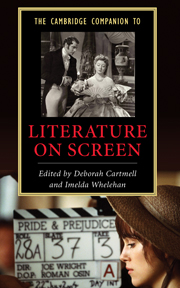Book contents
- Frontmatter
- Introduction - Literature on screen: a synoptic view
- Part One Theories of Literature on Screen
- Part Two History and Contexts
- Part Three Genre, Industry, Taste
- 8 Heritage and literature on screen: Heimat and heritage
- 9 “Don’t let’s ask for the moon!”: reading and viewing the woman’s film
- 10 Post-classical fantasy cinema: The Lord of the Rings
- 11 Adapting children's literature
- 12 Literature on the small screen: television adaptations
- Part Four Beyond the "Literary"
- Further reading
- Index
- Series List
8 - Heritage and literature on screen: Heimat and heritage
from Part Three - Genre, Industry, Taste
Published online by Cambridge University Press: 28 September 2007
- Frontmatter
- Introduction - Literature on screen: a synoptic view
- Part One Theories of Literature on Screen
- Part Two History and Contexts
- Part Three Genre, Industry, Taste
- 8 Heritage and literature on screen: Heimat and heritage
- 9 “Don’t let’s ask for the moon!”: reading and viewing the woman’s film
- 10 Post-classical fantasy cinema: The Lord of the Rings
- 11 Adapting children's literature
- 12 Literature on the small screen: television adaptations
- Part Four Beyond the "Literary"
- Further reading
- Index
- Series List
Summary
Heritage film, costume film, period film, literary adaptation - often these terms address an overlapping corpus of films. For a long time it has been unfashionable to view these films primarily as adaptations, in spite of the fact that even today the presumably long-dead fidelity criticism is still regularly evoked as a straw man in semiotic and narrative film studies. There is clearly an automatic difference between film and literature in terms of semiotic appearance and the widely different apparatus of production and reception. The adjective “literary” adaptation, as well as the recurrence of authors in titles (Bram Stoker's Dracula, 1992; Mary Shelley's Frankenstein, 1994), however, invoke the (untenable) primacy of literature as a cultural norm. In the medium-unspecific term “heritage” the transmedial cultural function of film, tourism, literature, educational and historical discourse emerges. All of these terms converge in the idea of a secondary, even subservient pastness of these films - a pastness which is divulged by costume, signalled by the “period” quality and implied in the canonized literary precursor. It follows that the terms “literary adaptation” and “heritage film” also converge in the idea of the canonical, in the body of cultural works accepted by consensus as valid and meaningful to a given community. Because of this, the term heritage film is useful in addressing issues of national, ethnic, cultural, class, and gender identities that are crucial in analyses of these films. This chapter attempts to account for the curious transnational and transcultural migration of heritage concepts which were originally and uniquely formulated in Britain, and are, for instance, largely absent from American research into adaptations and from period and costume films.
- Type
- Chapter
- Information
- The Cambridge Companion to Literature on Screen , pp. 123 - 137Publisher: Cambridge University PressPrint publication year: 2007
- 10
- Cited by

